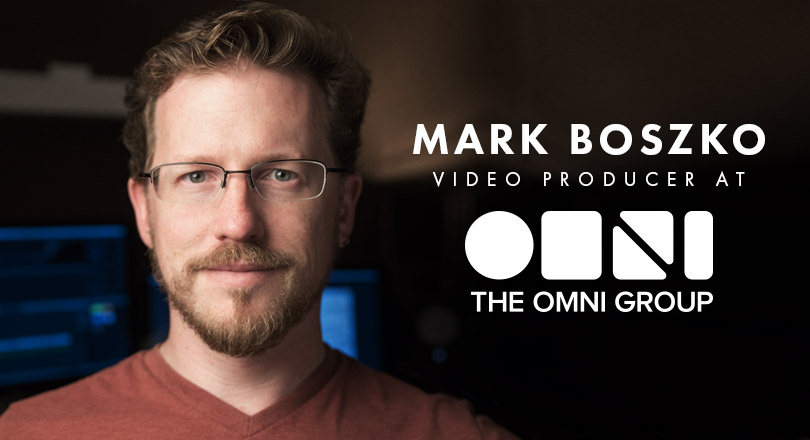Mark Boszko is an in-house video producer at The Omni Group, makers of exclusive Mac and iOS productivity software. Mark has worked across the industry and has been hooked on filmmaking since age five.
How did you get into video making?
When I was five, I saw a television special on the effects of The Empire Strikes Back, and I think that was the first time that I realized that hey – people actually make this stuff! Ever since then, I’ve been hooked on filmmaking and VFX.
I got into television under the assumption that it would be a stepping stone to feature film work, but I’ve found that they’re very different universes, with little overlap. Still, I made the best of it with my interest in the science-y side of things, which led to work at local production companies in the Maryland/DC area, editing and making motion graphics for shows on History, Discovery, National Geographic Television, and other non-fiction productions. I continued to work on the occasional short, like for the 48 Hour Film Project, and fun spec spots, like Attack of the Giant Amazon.
A year ago, I decided to stop being a freelance nomad and join The Omni Group, so we packed up the family and took a road trip across the country to our new home in Seattle. Along the way, we tried to stop at as many movie-related locations as we could, like the cemetery from Night of the Living Dead, Mount Rushmore (from North by Northwest, of course), and Devils Tower from Close Encounters of the Third Kind — man, how crazy is it that that thing actually exists? Of course, any and all free time that I had gained from having more regular work hours was soon filled by my new podcast about movies and VFX, The Optical.
Where do you go for inspiration?
I do a lot of motion graphics, so Motionographer is a nice stop for inspiration, but I really love Art of the Title, which archives and categorizes motion picture title sequences, both new and old. There’s a lot of great inspiration in there — I especially love work from Saul Bass, Maurice Binder, and Pablo Ferro. I also love seeing what the latest tutorial is from Andrew Kramer – even if it’s not something I can use directly, it may spark an idea about how to frame a concept down the road.
Really, watching new (and new-to-me) films is one of the biggest ways that I get exposed to new images and new ideas, so it’s an eternally evolving mélange of inputs. I love seeing the latest VFX-heavy spectacle (and reading the Cinefex article on how it was put together), but I’m also making my way through Roger Ebert’s Great Movies list, which exposes me to a lot of things I never would have stumbled across otherwise. It’s my film school.
Who do you admire?
There are a lot of film directors who inspire me, but I really admire my close friend AAl (yes, that’s two capital A’s), whom I’ve known since high school, and who is the hardest working guy I know. He’s taken a little comedy column he used to write for friends back in the early AOL days, “Sarcastic Voyage”, and turned it into an ever-evolving creative venture, that has most recently taken the form of a sketch-comedy podcast that marked its fifth anniversary and 180th episode with a live performance here in Seattle.
He and I have argued a lot over the years over how we approach the creative process (it usually boils down to “now” vs. “better”), but he’s taught me a lot about the value of persistence, and I’m fascinated and gratified to see him producing the work he’s doing now, all these years later.



